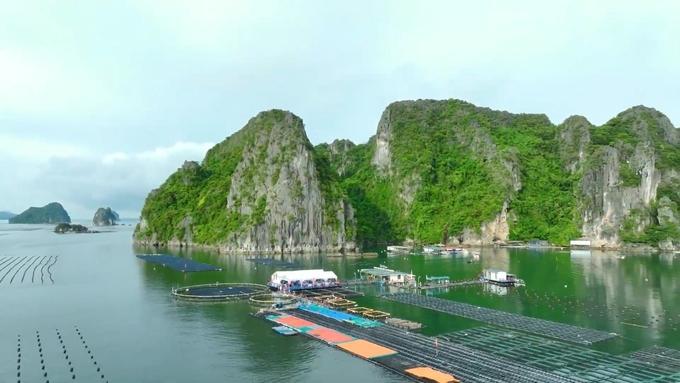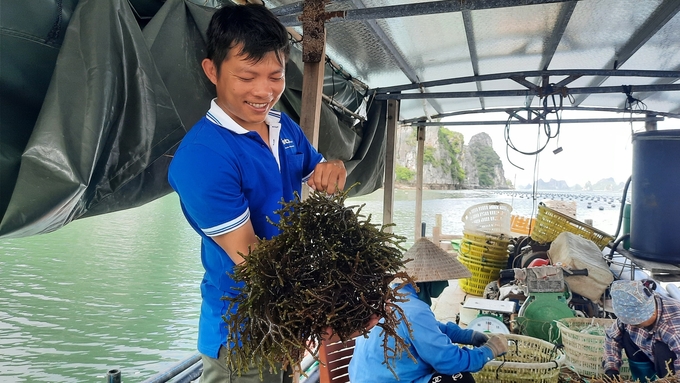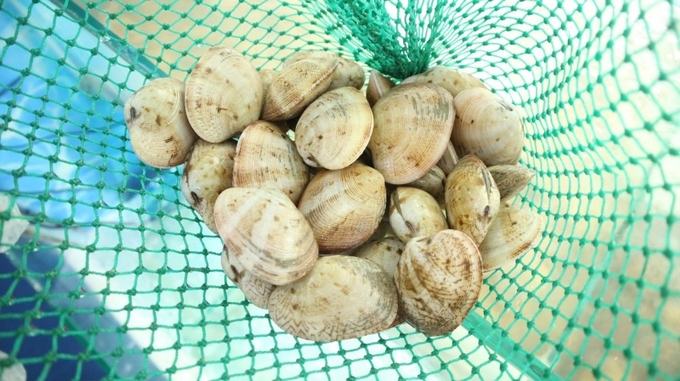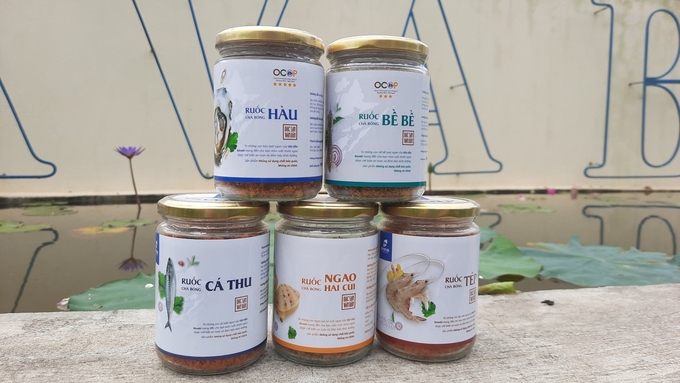November 22, 2025 | 22:25 GMT +7
November 22, 2025 | 22:25 GMT +7
Hotline: 0913.378.918
November 22, 2025 | 22:25 GMT +7
Hotline: 0913.378.918

The oyster - seaweed intercropping model in Van Don district, jointly invested by STP Group. Photo: Van Nguyen.
In addition to tourism, aquaculture specifically mollusk farming is currently the main income for people in Van Don district, Quang Ninh province. This locality orients developing sustainable oyster farming in parallel with environmental protection.
The aquaculture model in Ha Long commune, Van Don district has an infrastructure system entirely made of environment-friendly high density polyethylene (HDPE) material. The model is spread over an area of approximately 5 ha, including 1 ha of oysters and 4 ha of elkhorn sea moss intercropped. It is known that this model is a chain cooperation between STP Group and Phat Co Cooperative led by Nguyen Sy Binh.
“When integrating sea moss farming with oysters, the sea moss will clean the oyster’s living environment as well as the food source. This improves the quality of oysters as they become healthier, better developed, and meet the standards in the production, processing and consumption chain," said Binh.

Oysters and elkhorn sea moss when intercropped will help each other grow well by making the water environment cleaner. Photo: Nguyen Thanh.
It is known that STP Group successfully tested the model of intercropping elkhorn sea moss with Pacific oysters in 2021. In the same year, Phat Co Cooperative cooperated with STP Group in implementing a production - consumption chain for these two agro-products. Now farmers can produce in peace and no longer have to worry about the output.
Currently 1 ha of Binh's oyster farm harvests more than 100 tons/year. As for the 4 ha elkhorn sea moss farm, the yield is 200 tons/year. The current selling price of oysters is VND 6,000 - 9,000/kg, while elkhorn sea moss is sold at VND 6,000/kg fresh, VND 55,000/kg dry. Thanks to this intercropping model, Binh earns over VND 2 billion per year.

Elkhorn sea moss can be harvested after 70 days, 1 ha can produce 50 tons of fresh sea moss per year. Photo: Van Nguyen.
According to Do Dinh Minh, Director of Quang Ninh Sub-Department of Fisheries, the province will soon have a plan for aquaculture areas, including marine farming. It is estimated that each household will be allocated 1 ha of water surface area.
“Instead of just doing single-species culture and focusing mainly on the basic nutritional needs of that species, multi-layered farming can create a culture environment similar to a small natural ecosystem. For example, the combination of oyster and fish farming with clam, Pacific geoduck, sea cucumber and seaweeds forms a cluster close to each other, making each species a ‘live filter’ for the farming environment”.

Tapes dorsatus (dual core white clam) is one of the molluscs that can be integrated into the multi-layered farming model in Quang Ninh. Photo: Nguyen Thanh.
Multi-layered farming allows the leftovers, waste, nutrients and by-products of one species to be recovered and converted as useful products, food and energy for the growth of other species. When implemented strategically, this farming method can diversify farm products and provide ecosystem benefits, such as improved environmental quality, additional income for farmers, and full exploitation of the allocated water surface area.
Director Minh said, “In 2014, oysters sold for VND 35,000/kg. This can be considered the heyday of oysters. However, the widespread, unplanned farming of oysters caused supply to exceed demand, leading to a reduction in value”.
Quang Ninh currently has 10,000 ha of oyster farming, but only 6,000 ha is in the farming area planning. Every year, the income from oyster farming is roughly VND 1,500 billion at the price of VND 6,000/kg.

Using environment-friendly HDPE floating material is becoming more popular among oyster farmers in Quang Ninh. Photo: Nguyen Thanh.
“If we return to the VND 35,000/kg price rate, the revenue from oysters would be. But we hope to create a better environment for oysters to grow in the near future, after re-planning the farming area. The output of oysters may decrease, but the price will definitely be better, reaching VND 10,000 - 15,000/kg. When that time comes, the oyster will be able to create economic value, maybe 2-3 times more than the current period," said Director Minh.

Deep-processed products from clams and oysters all achieve OCOP quality from 3 to 5 stars, consumed at home and abroad. Photo: Nguyen Thanh.
In addition to the potential for aquaculture development, Quang Ninh also has the advantage of having a border with China, one of the major powers in the production and consumption of fishery products, especially fresh seafood. Hong Kong, Taiwan, and Japan are also huge seafood consumption markets for Vietnam in general and Quang Ninh in particular.
One thing to note is that the domestic consumption market is not small, particularly since Quang Ninh is a destination where people from all over the world come to visit, and its fishery products have gained a fair amount of popularity in the past few years. From those potentials and advantages, mollusk farming is expected to bring in trillions of VND per year, contributing to the goal of making Vietnam’s fishery a billion-dollar industry.
Translated by Samuel Pham

(VAN) Results from the Sustainable Durian Model Project in Dak Lak have confirmed the critical role of Yara Viet Nam in transferring advanced nutritional solutions to farmers.

(VAN) In Tuyen Quang province, livestock farmers have introduced effective models and innovative practices that significantly strengthen African Swine Fever prevention and control efforts.

(VAN) This is the study conducted by IRRI and Can Tho University on the rice straw value chain in Mekong Delta showing an economic potential of more than 6.6 trillion VND/year.

(VAN) By participating in cooperative economics, many farmers in Tay Ninh have overcome hardship, mastered clean dragon fruit cultivation techniques.

(VAN) The crossbreeding program in the former Binh Dinh province (now part of Gia Lai) has shown signs of decline, and urgent measures are needed to revive it and sustain past achievements.

(VAN) The agricultural sector agreed on a roadmap to pilot the MRV protocol and expand low-emission rice production from the 2025-2026 winter-spring crop.

(VAN) Agricultural extension officers in Quang Ninh do more than transmit knowledge; they have become a steadfast support system for farmers on the path to sustainable agricultural development.